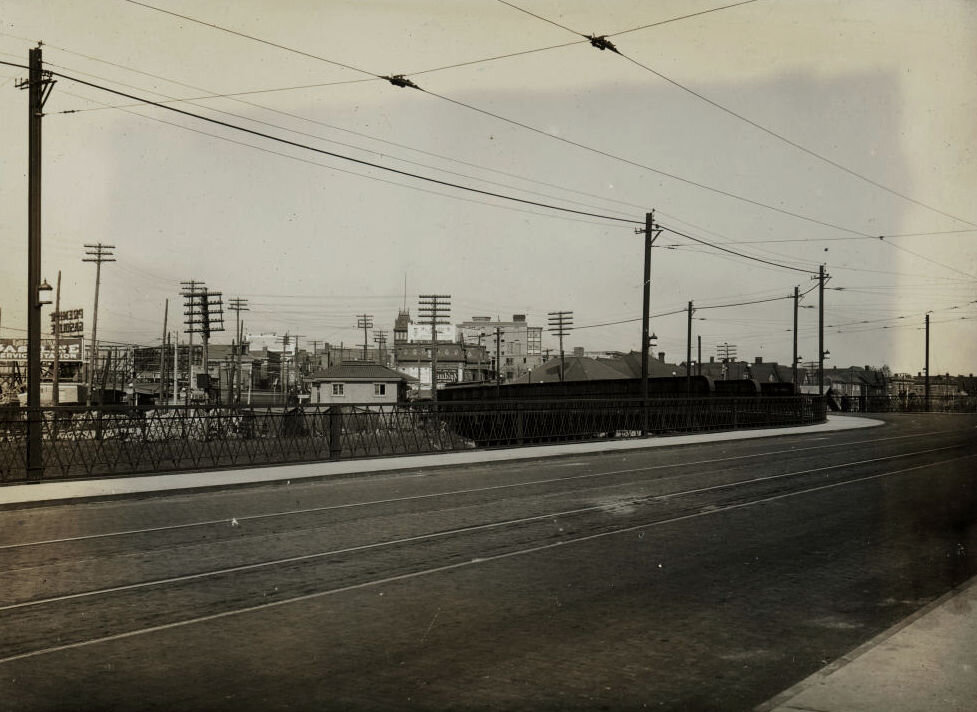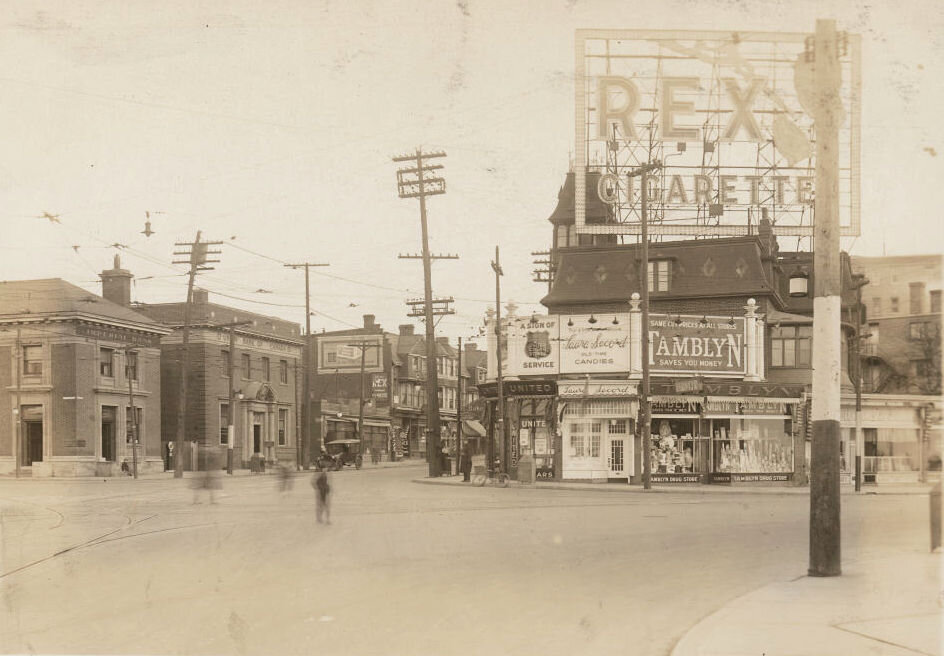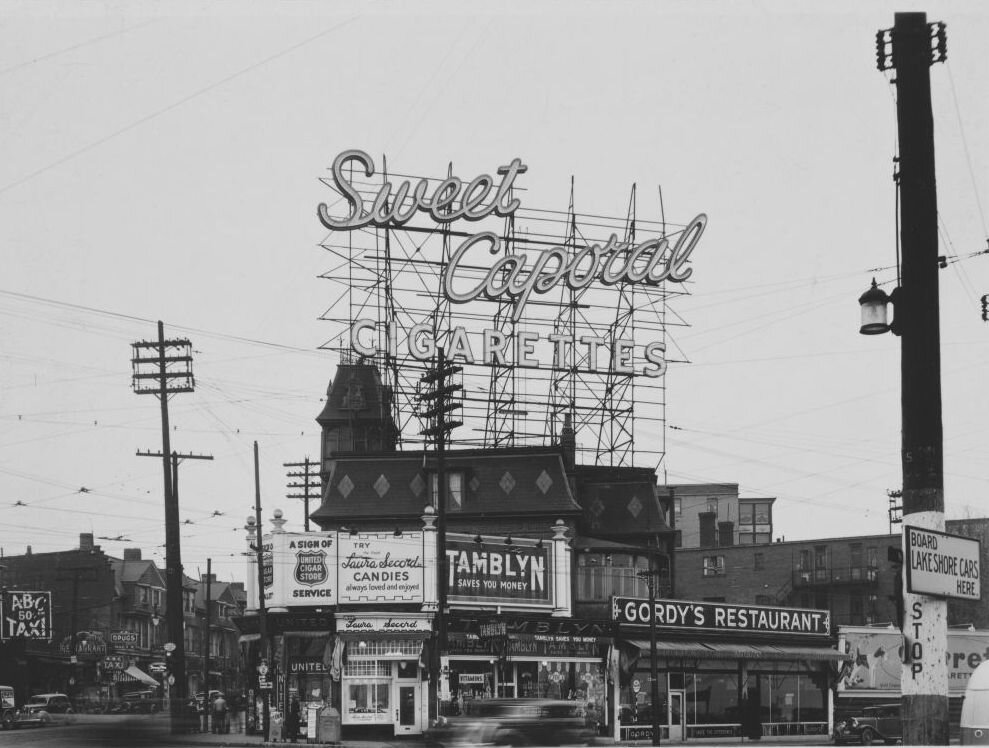Ocean House Hotel Revisited
/Introduction
The history of the Ocean House Hotel was one of my favourite local history subjects to research. This article supplements the original column with information I have recently gathered from exploring the history of the hotel. Parkdale was my neighbourhood in my first two years of university. As a Polish-Canadian person, I have fondness for Roncesvalles Avenue.
In 2005, the former hotel at the junction of Roncesvalles Avenue, Queen Street West, and King Street West housed the venerable Sam the Chandelier Man, Easy Restaurant, and a daycare. The main floor was dominated by a grungy, twenty-four-hour Coffee Time. The Park Hotel opened in December, 1884 and was designed by James Davis in the style of Second Empire, with a dichromatic mansard roof, iron cresting around the central cupola (which offered spectacular view of Lake Ontario and downtown), and elliptical dormer windows on the top floor.
Parkdale: From a Fancy Floral Suburb to a Resort Town
The attractive, late nineteenth-century red and yellow brick façade is remniscient of the time when Parkdale was a fashionable residential district that by the early 1920s morphed in to the city’s entertainment district within a close proximity to the Sunnyside Amusement Park. The changes to the appearance and the functions of the hotel are reflective of the broader social and economic transformations in the neighbourhood. In addition to Sunnyside, South Parkdale boasted four movie houses, dance halls (including Palais Royal), numerous restaurants, and other places of amusement within a walking distance of the hotel, which featured “the longest hotel bar in town, complete with brass rails and swinging doors,” as proudly recounted by a long-time resident of the neighbourhood, B.A. Lillie, on the pages of Parkdale Citizen.
Apartments for Fashionable Bachelors
The hotel ceased to rent the rooms on the second and third floors after the Ontario Temperance Act was enacted in 1916. W.R. Reid, the owner of United Cigar Stores Limited, purchased the hotel in 1921 from John E. Laxton and converted the rooms into a series of bachelor apartments called The Boulevard (after nearby Sunnyside Boulevard, the site of the nearby amusement park). The Boulevard Apartments (mailing address 1645 Queen Street West), were rented on a weekly basis, at a rate of $4 to $5 in 1937 (about $70 to $90 dollars today, adjusted for inflation).
According to the ads placed in the Toronto Daily Star, the flats were located at an “[a]ttractive location,” offering “[b]right, airy, well furnished rooms, overlooking lake at Sunnyside, first-class service.” The transformation of the hotel rooms into apartments mirrored the conversion of many mansions and large homes into rooming houses in Parkdale following World War II, when widowed residents took in borders to offset mortgage payments and other expanses. Reid also bought the lot in front of the building (occupied by a sidewalk), which allowed him to expand and subdivide the ground floor and the former lobby into four storefronts.
Ruth Frocks
Ruth Frocks was an important institution in the history of fashion and fashion retail and design in Toronto. Opened at 1637 Queen Street West in the 1940s, the boutique offered a range of custom-designed women’s formal apparel, ready-to-wear, casual clothing, outerwear, activewear, swimwear, lingerie, wigs, jewellery, and a complete range of accessories, but it was the most famous and reputable for its line of the in-house designed wedding attire. An “exquisite Designers Collection” included gowns for the bride, her attendants, and even flower girls.
A personal consultation service assisted brides with selecting the latest couture styles and fabrics for their weddings and also provided them with customized fittings and alterations. Maud Burgess was the manager of the bridal salon for a number of years and also designed headdresses. The salesgirls were required to have a “happy disposition,” as described in a 1956 employment ad placed in the Toronto Daily Star and they were offered “excellent working conditions, top wages,” and commission. They also had to have a “good knowledge of dresses, suits, coats, and accessories.”
Adam Eckhardt, a Royal Airforce Pilot who served in World War Two, purchased the store for $1,000 with an allowance he received after his discharge from the RAF in 1947. Although Eckhardt had no previous retail or mechandising experience, he and his wife, Phyllis, turned the struggling shop around and even enlarged the floor space into the storefront next door. In the early sixties, Ruth Frocks achieved Canada-wide reputation: the in-store designer, Regina Lesniak, served as many as twenty brides per week, who came to shop from as far as North Bay, Collingwood, and Vancouver.
The store was expanded again in November 1964 and occupied the prime central part of the building, flunked by the junction of the three streets, occupying a “landmark corner” of the city from 1637 to 1643 Queen Street West. The white façade enlivened the gritty, drab corner. A local fashion columnist who attended the grand reopening of Ruth Frocks described with feverent dedication the prominence of the boutique in the lives of Toronto’s well-dressed, modern women, “a very special store to a great many people”:
“R.F. is the one store where you get all the requsites for a fashionable wordrobe, day dresses, evening elegance, cocktail excitement, and suits that go anywhere, in quiet, unharried elegance, whisking you through a busy day at the office, breezing you through luncheon dates, tirelessly taking you on the ‘after five’ theatre or just lounging at home.”
The Eckhardts operated Ruth Frocks until the early 1980s. Unforunately A. Eckardt Limited filed for bankruptcy twice, first in May, 1972 and in September, 1980. However, the personlized service set the shop apart from the mass-produced fare offered by chain clothing stores located in malls until at least three and a half years later. Historical photographs from the City of Toronto Archives depict the store open on July 18th, 1983. Running an upscale bridal boutique in an inner-city neighbourhood that had long lost its prestige and money must have been challenging for the couple. The main commercial strip of the old neighbourhood, on Queen Street West from Dufferin Street to Roncesvalles Avenue, consisted of discount stores, fast-food restaurants, laundromats, and second-hand furniture stores. South Parkdale also had the highest concentration of rooming homes and other supportive housing. The Eckhardts were aware that the success of their business was rooted in Parkdale, in the former Ocean House Hotel, and they
“watched the neighborhood undergo ‘such change that you could not recognize it from what it was.’ Today, they’re keenly aware of the community’s problems, such as homes that have been converted into ill-kept boarding houses. But they plan to stay where they are. ‘We considered expanding into a shopping centre, but that’s too impersonal,’ says Eckhardt.”
Despite its status as an long-standing Toronto institution and the Eckhardts’ devotion to the bygone charm of the old neighbourhood, Ruth Frocks ceased to operate.
Gallery














References & Further Reading
Dickason, Olive. “Elegant Styles for the Bride’s Trip to the Altar.” The Globe and Mail, 16 Jun. 1982, pp. A18–A19.
“The Homestyle Side of Business.” The Toronto Daily Star, 26 Jun. 1983, p. D2.
Laycock, Margaret, and Barbara Myrvold. Parkdale in Pictures: Its Development to 1889. Toronto Public Library Board, 1991.
McCaffrey, Gordon. “‘Sibera was Worse’—Northway Boss.” The Toronto Daily Star, 17 Mar. 1962, p. 12.
Malleck, Dan. Try to Control Yourself: The Regulation of Public Drinking in Post-Prohibition Ontario, 1927–44. UBC Press, 2012.
Mulvany, Charles Pelham, Adam, G. Mercer, and Robinson, Christopher Blackett. History of Toronto and County of York, Ontario: Containing a History of the City of Toronto and the County of York, with the Townships, Towns, Villages, Churches, Schools, General and Local Statistics, Biographical Sketches, etc., etc. C.B. Robinson, 1885.
Rex, Kathleen. “Changes in the Wind for Parkdale.” The Globe and Mail, 10 Mar. 1982, p. M1.
“Shop-’n-Talk with Liz.” The Toronto Daily Star, 4 Nov. 1964, p. 64.
“Shop-’n-Talk with Liz.” The Toronto Daily Star, 24 Nov. 1964, p. 58.
Walpole, Mary. “Around the Town with Mary Walpole: A Regular Advertising Feature.” The Globe and Mail, 15 Apr. 1970, p. 11.
Whitzman, Carolyn. Suburb, Slum, Urban Village: Transformations in Toronto’s Parkdale Neighbourhood, 1875–2002. UBC Press, 2009.
“United Cigar President Buys the Ocean House.” The Toronto Daily Star, 6 o’clock edition, 12 Aug. 1921, p. 1.

